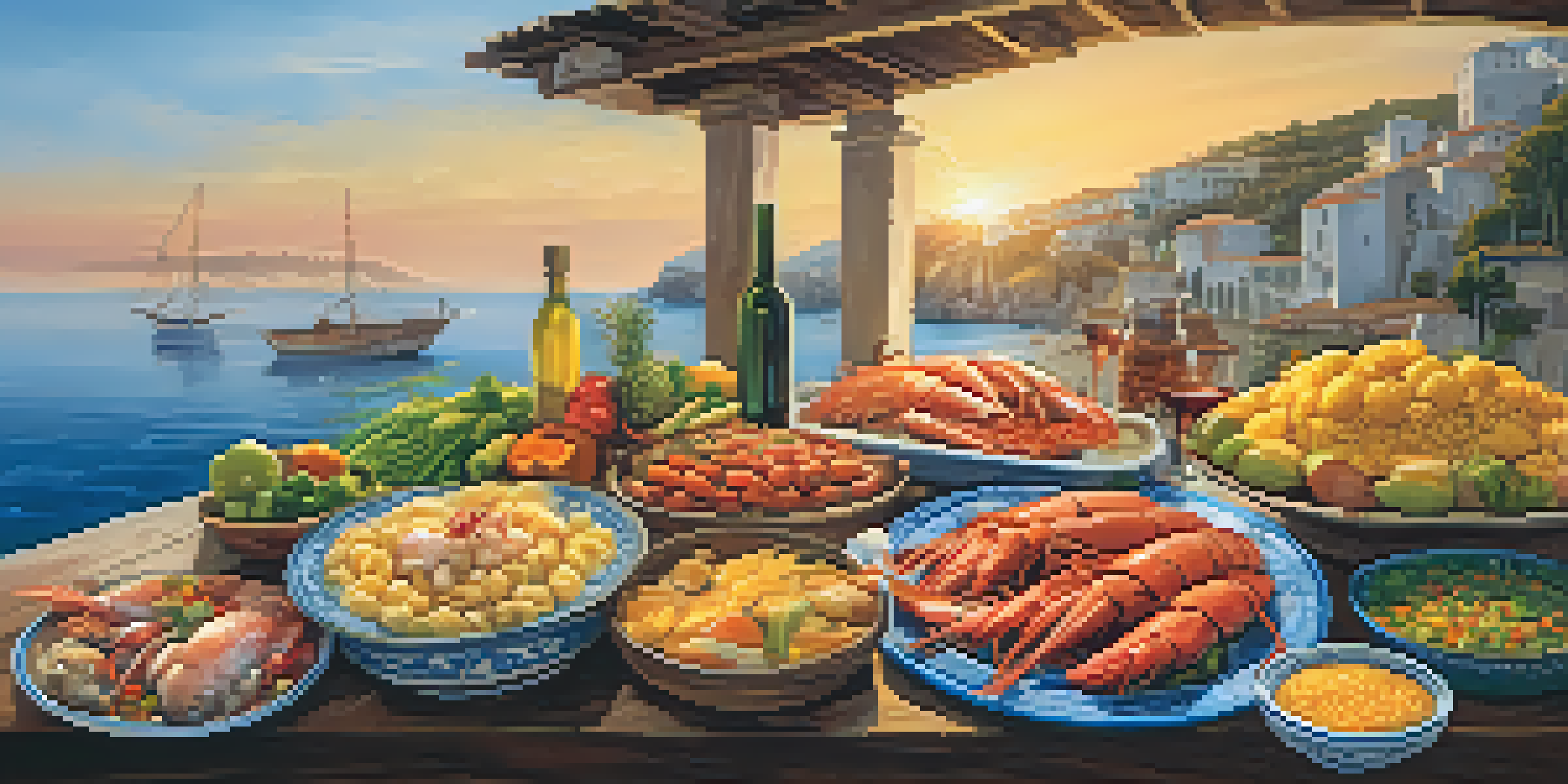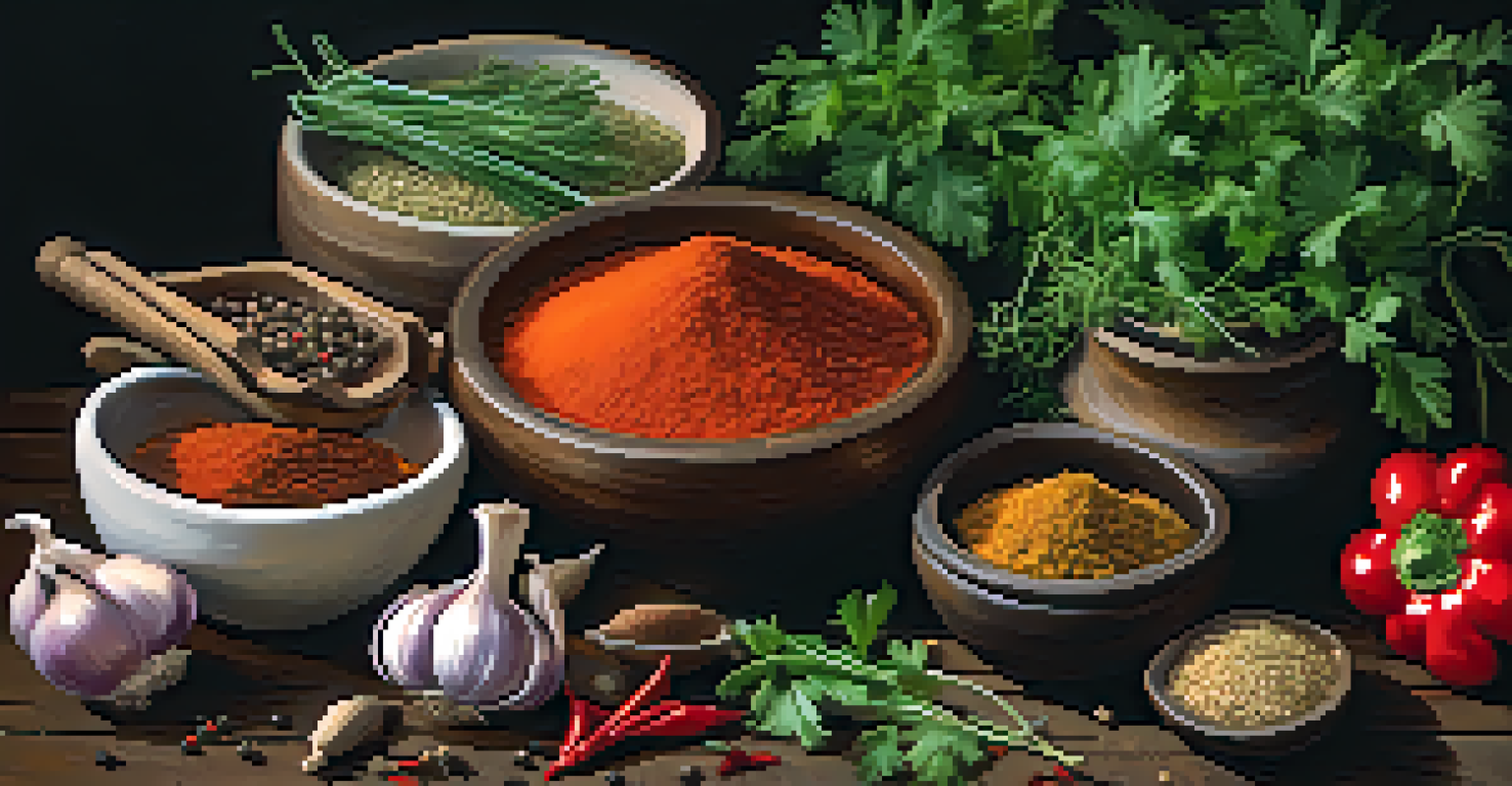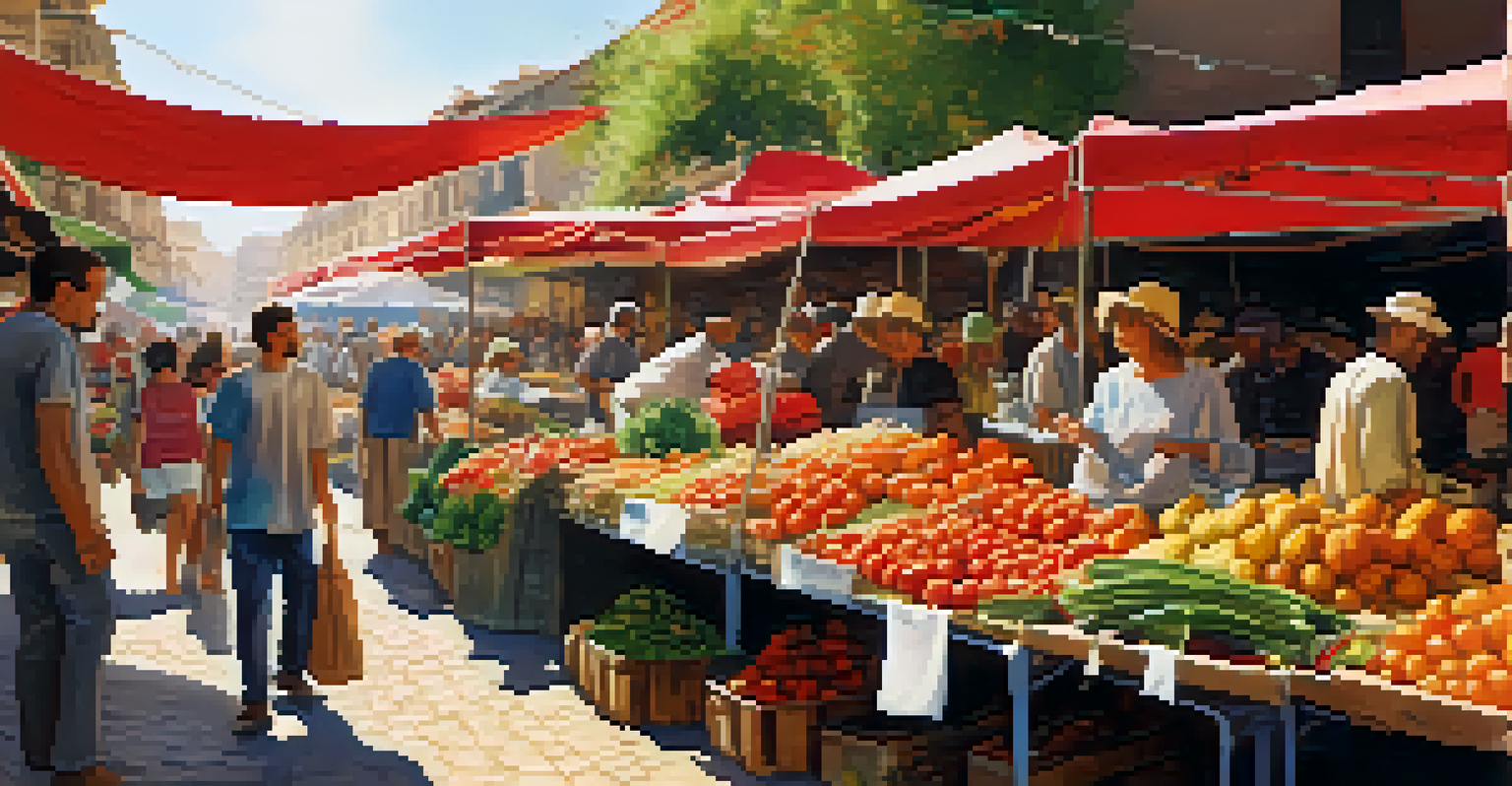The Role of Ingredients in Spain's Historical Gastronomy

The Influence of Geography on Spanish Ingredients
Spain's diverse geography plays a pivotal role in its gastronomy. From the coastal regions that provide fresh seafood to the fertile plains of La Mancha that yield grains and olives, the landscape shapes what ingredients are available. Each area boasts its own unique flavors, making Spanish cuisine a delightful tapestry of regional specialties.
Food is the ingredient that binds us together.
For instance, the Mediterranean coast is known for its vibrant use of tomatoes and peppers, while the mountainous regions favor heartier ingredients like meats and potatoes. This geographical variety means that no two Spanish dishes are quite alike, each reflecting the local terrain and climate. As a result, the ingredients themselves tell a story of the land and its people.
Understanding this connection between geography and ingredients helps us appreciate the depth of Spanish cuisine. It’s not just about what’s on the plate; it’s about where it comes from and how the environment influences flavor. This foundational aspect of Spanish gastronomy sets the stage for exploring its historical significance.
The Historical Impact of the Moors on Spanish Ingredients
The arrival of the Moors in the 8th century brought a wealth of new ingredients and culinary techniques to Spain. This era introduced spices like saffron and cinnamon, which transformed traditional cooking methods and added depth to Spanish flavors. The blending of cultures created a unique fusion that is still evident in many dishes today.

For example, the use of almonds in both sweet and savory dishes can be traced back to this period. The famous Spanish dish, 'pisto,' a ratatouille-like vegetable medley, often includes nuts, showcasing the Moorish influence. This historical intertwining not only enriched Spanish cuisine but also highlighted the importance of cultural exchange.
Geography Shapes Spanish Cuisine
Spain's diverse landscapes influence the variety of ingredients used in its regional dishes.
Exploring the impact of the Moors helps us understand how ingredients are not merely food items; they are carriers of history and tradition. Each spice or nut has a story, and together they form a narrative that reflects centuries of interaction and adaptation in Spain's culinary landscape.
The Role of Olives and Olive Oil in Spanish Cooking
Olive oil is often referred to as the lifeblood of Spanish cuisine, and for good reason. Spain is the world's largest producer of olives, and the oil extracted from them is central to many traditional dishes. From drizzling over fresh salads to frying tapas, olive oil enhances flavor while also providing health benefits.
Cooking is like love; it should be entered into with abandon or not at all.
The cultivation of olives dates back thousands of years, with evidence suggesting that the Phoenicians introduced the practice to Spain. Today, various regions produce distinct types of olive oil, each with its own flavor profile. This diversity allows chefs to choose the perfect oil for their dishes, much like a painter selects colors for a masterpiece.
The significance of olive oil extends beyond its culinary uses; it represents a way of life in Spain. Meals are often centered around shared dishes, with olive oil acting as a common ingredient that brings people together. This connection to both food and community is a hallmark of Spanish gastronomy.
Seafood: A Key Component of Coastal Spanish Dishes
Living by the sea has profoundly influenced Spain’s culinary identity, particularly in seafood dishes. With its extensive coastline, Spain offers a rich variety of fish and shellfish that are integral to local cuisine. Dishes like paella and grilled sardines highlight the freshness of these ingredients and the skill of Spanish cooks.
Regions such as Galicia are renowned for their seafood, where the ocean provides everything from octopus to clams. The traditional Galician dish 'pulpo a la gallega' showcases octopus, emphasizing the importance of regional specialties that celebrate local bounty. Each bite reveals the ocean's influence on Spanish flavors.
Moors Enhanced Spanish Flavors
The introduction of spices and culinary techniques by the Moors enriched Spanish cuisine and highlighted cultural exchange.
Seafood in Spain is not just about sustenance; it’s a celebration of the maritime culture. Festivals often revolve around seafood dishes, bringing communities together. This connection to the sea reinforces the idea that ingredients in Spanish gastronomy are deeply intertwined with local heritage and cultural practices.
Herbs and Spices: Enhancing Flavor in Spanish Recipes
Herbs and spices play a crucial role in defining the flavors of Spanish cuisine. Ingredients like paprika, garlic, and parsley are staples in many dishes, adding depth and warmth to recipes. These elements not only enhance taste but also connect to the historical trade routes that introduced these bold flavors to Spain.
Paprika, in particular, has become synonymous with Spanish cooking, thanks to its roots in the region of La Vera. The distinct smoky flavor of this spice is used in everything from chorizo to stews, illustrating how a single ingredient can shape an entire cuisine. This highlights the importance of sourcing quality herbs and spices for authentic flavors.
Understanding the role of herbs and spices allows us to appreciate the art of cooking in Spain. They are not merely additions to dishes; they are essential components that evoke regional identities and traditions. The careful selection of these ingredients showcases the passion and creativity inherent in Spanish gastronomy.
The Importance of Seasonal Ingredients in Spanish Cuisine
In Spanish cooking, the use of seasonal ingredients is a cherished practice that reflects a deep respect for nature. Chefs prioritize fresh, local produce, ensuring that each dish highlights what’s available at any given time of year. This approach not only enhances flavor but also supports sustainability and local farmers.
For instance, tomatoes are at their peak in summer, making them a star ingredient in dishes like gazpacho. Meanwhile, fall brings a bounty of mushrooms and squash, which find their way into hearty stews. By embracing the seasons, Spanish cooks create vibrant dishes that change throughout the year, keeping the culinary landscape dynamic.
Seasonal Ingredients Matter
Using seasonal ingredients allows Spanish chefs to create vibrant dishes that reflect the best of nature throughout the year.
This commitment to seasonal cooking fosters a connection between the eater and the environment. It encourages a mindful approach to food, where each meal is an opportunity to savor the best that nature has to offer. This philosophy is a key aspect of Spain’s rich gastronomic heritage.
The Fusion of Tradition and Modernity in Spanish Cuisine
As Spanish gastronomy has evolved, there has been a fascinating blend of traditional and modern culinary practices. Chefs today are taking classic dishes and reinterpreting them with innovative techniques and ingredients, breathing new life into age-old recipes. This fusion creates a culinary landscape that respects heritage while embracing creativity.
For example, contemporary interpretations of tapas often include unexpected elements, such as molecular gastronomy techniques. This playful approach captivates diners and invites them to experience familiar flavors in new ways. It shows that while ingredients may hail from tradition, their potential is limitless in modern cooking.

The balance between tradition and modernity ensures that Spanish cuisine remains relevant and exciting. It fosters a dialogue between past and present, allowing chefs to honor their roots while also pushing culinary boundaries. This dynamic interplay is what keeps Spanish gastronomy vibrant and continually evolving.